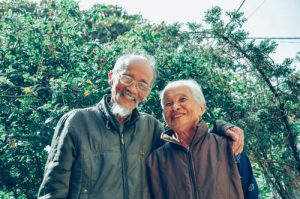Written by Chrystal Moulton, Staff Writer. Multivariable-adjusted analysis showed that polyphenol antioxidant content (PAC) score was inversely associated biological age.
 Aging can be understood in two ways: 1) chronological aging and 2) biological aging. Chronological age refers to the actual age of the person. Biological age refers to the functional condition of one’s internal organs. The difference between the two can be used to understand a person’s health status. In general, when the difference between biological age and chronological age is a positive number, this indicates an acceleration in biological aging whereas when the difference is negative this indicates decelerated biological aging 1. The difference between biological age and chronological age has been associated with mortality, disability, and chronic disease morbidity 2,3. Understanding how a diet rich in polyphenols could affect the outcomes of biological aging still needs to be understood. In the current study, researchers used data from the MOLI- Sani study to discover any association between total antioxidant capacity and dietary polyphenols with biological aging 4.
Aging can be understood in two ways: 1) chronological aging and 2) biological aging. Chronological age refers to the actual age of the person. Biological age refers to the functional condition of one’s internal organs. The difference between the two can be used to understand a person’s health status. In general, when the difference between biological age and chronological age is a positive number, this indicates an acceleration in biological aging whereas when the difference is negative this indicates decelerated biological aging 1. The difference between biological age and chronological age has been associated with mortality, disability, and chronic disease morbidity 2,3. Understanding how a diet rich in polyphenols could affect the outcomes of biological aging still needs to be understood. In the current study, researchers used data from the MOLI- Sani study to discover any association between total antioxidant capacity and dietary polyphenols with biological aging 4.
MOLI-Sani study was a large population-based cohort study conducted to assess environmental risk factors associated with the onset of cerebrovascular, cardiovascular and tumor diseases 5. Data collection was performed between 2005 and 2010 and consisted of 24,325 participants. A machine learning algorithm was used to calculate biological age based on 36 biomarkers, sex, age [chronological age], and recruiting location. A food frequency questionnaire was used to assess diet over the past year. Total antioxidant content (TAC) and polyphenol antioxidant content (PAC) was calculated from data receive through the food frequency questionnaire. Associations were calculated using multi-variable adjusted linear regression based on two models. Model 1 adjusted for sex, age, and energy intake. Model 2 adjusted for dietary fiber, hyperlipidemia, diabetes, menopausal status, smoking, physical activity, BMI, Cardiovascular Disease, cancer, hormone replacement, and education in addition to items in model 1.
Multivariable-adjusted analysis showed that polyphenol antioxidant content (PAC) score was inversely associated with the difference between chronological and biological age (beta = – 0.27, P = 0.05). No specific subclasses of polyphenols were associated with biological aging. With regards to total antioxidant capacity and antioxidant content, subclasses differed by biological sex. Flavanols were inversely correlated with the difference between chronological and biological age in men (beta= negative 0.09, P<0.0001). In women however, flavanols were positively correlated with the difference in chronological and biological age (Beta = 0.17, P <0.0001). In women, isoflavones and flavones are inversely associated with the difference in chronological and biological age. The result was opposite from male participants. In both men and women lignans were positively associated with the difference between chronological and biological age. See Table 1 for details (these results were adjusted according to model 2).
Table 1. Association between polyphenol class and difference in chronological & biological age in men and women| Polyphenol Class | Men | Women | P-value |
|---|---|---|---|
| Flavanols | -0.09 | 0.17 | |
| Flavones | 0.14 | -0.15 | 0.0002 |
| Isoflavones | 0.32 | -0.04 | 0.02 |
| Lignans | -0.13 | -0.18 | 0.02 |
Values are beta-coefficient scores adjusted according to model 2
In the end, polyphenol antioxidant content was significantly associated with a deceleration in biological aging. Specific polyphenols were identified affecting the biological aging in men and women. Further studies would need to elucidate the relationships between specific polyphenols and aging in men and women.
Source: Esposito, Simona, Alessandro Gialluisi, Simona Costanzo, Augusto Di Castelnuovo, Emilia Ruggiero, Amalia De Curtis, Mariarosaria Persichillo et al. “Dietary Polyphenol Intake Is Associated with Biological Aging, a Novel Predictor of Cardiovascular Disease: Cross-Sectional Findings from the Moli-Sani Study.” Nutrients 13, no. 5 (2021): 1701.
© 2021 by the authors. Licensee MDPI, Basel, Switzerland. This article is an open access article distributed under the terms and conditions of the Creative Commons Attribution (CC BY) license (http://creativecommons.org/licenses/by/4.0/).
Click here to read the full text study.
Posted July 13, 2021.
Chrystal Moulton BA, PMP, is a 2008 graduate of the University of Illinois at Chicago. She graduated with a bachelor’s in psychology with a focus on premedical studies and is a licensed project manager. She currently resides in Indianapolis, IN.
References:
- Gialluisi A, Di Castelnuovo A, Donati MB, de Gaetano G, Iacoviello L. Machine Learning Approaches for the Estimation of Biological Aging: The Road Ahead for Population Studies. Front Med (Lausanne). 2019;6:146.
- Levine ME. Modeling the rate of senescence: can estimated biological age predict mortality more accurately than chronological age? The journals of gerontology Series A, Biological sciences and medical sciences. 2013;68(6):667-674.
- Gialluisi A, Di Castelnuovo A, Costanzo S, et al. Exploring domains, clinical implications and environmental associations of a deep learning marker of biological ageing. medRxiv. 2021.
- Esposito S, Gialluisi A, Costanzo S, et al. Dietary Polyphenol Intake Is Associated with Biological Aging, a Novel Predictor of Cardiovascular Disease: Cross-Sectional Findings from the Moli-Sani Study. Nutrients. 2021;13(5).
- Licia Iacoviello M, BcSc AB, De Curtis A, Francesco Zito M, Donati MB, Giovanni de Gaetano M. The Moli-Sani Project, a randomized, prospective cohort study in the Molise region in Italy; design, rationale and objectives.



















